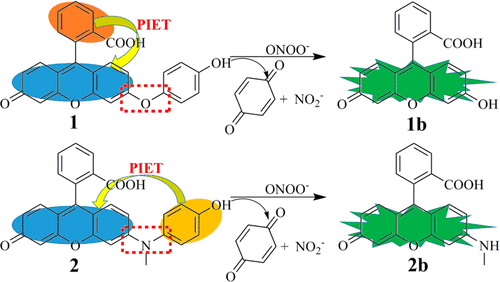当前位置:
X-MOL 学术
›
J. Phys. Chem. A
›
论文详情
Our official English website, www.x-mol.net, welcomes your
feedback! (Note: you will need to create a separate account there.)
Theoretical Study on the Photoinduced Electron Transfer Mechanisms of Different Peroxynitrite Probes
The Journal of Physical Chemistry A ( IF 2.7 ) Pub Date : 2017-12-29 00:00:00 , DOI: 10.1021/acs.jpca.7b10716 Li Li 1 , Minghui Zan 1 , Xingwang Qie 1 , Juan Yue 1 , Peng Miao 1 , Mingfeng Ge 1 , Zhimin Chang 1 , Zheng Wang 1 , Fu-Quan Bai 2 , Hong-Xing Zhang 2 , James K. Ferri 3 , Wen-Fei Dong 1
The Journal of Physical Chemistry A ( IF 2.7 ) Pub Date : 2017-12-29 00:00:00 , DOI: 10.1021/acs.jpca.7b10716 Li Li 1 , Minghui Zan 1 , Xingwang Qie 1 , Juan Yue 1 , Peng Miao 1 , Mingfeng Ge 1 , Zhimin Chang 1 , Zheng Wang 1 , Fu-Quan Bai 2 , Hong-Xing Zhang 2 , James K. Ferri 3 , Wen-Fei Dong 1
Affiliation

|
The development of probes for rapid and selective detection of peroxynitrite in vivo is of great importance in biological science. We investigate different photoinduced electron transfer (PIET) processes of two generations of peroxynitrite probes. Each has fluorescein and phenol moieties; one is conjugated by an ether linkage while the other is conjugated via an amine linkage. Using theoretical calculations, we demonstrated that the PIET in the probe with an ether linkage occurs from the benzoic acid to the xanthene moiety. In contrast, the PIET in the probe with an amine linkage occurs from the phenol moiety to the fluorescein. This suggests that better sensitivity can be accomplished in probes with an amine linkage than with an ether linkage. Following this model, we designed two novel peroxynitrite probes and simulated their detection capabilities in the near-infrared region.
中文翻译:

不同亚硝酸根探针光致电子转移机理的理论研究
用于体内快速和选择性检测过氧亚硝酸盐的探针的开发在生物科学中非常重要。我们调查了两代过氧亚硝酸盐探针的不同光诱导电子转移(PIET)过程。每个都有荧光素和酚部分;一个通过醚键结合,而另一个通过胺键结合。使用理论计算,我们证明了带有醚键的探针中的PIET从苯甲酸到the吨部分发生。相反,探针中具有胺键的PIET从酚部分到荧光素发生。这表明具有胺键的探针比具有醚键的探针可以实现更好的灵敏度。根据该模型,我们设计了两种新颖的过氧亚硝酸盐探针,并模拟了它们在近红外区域的检测能力。
更新日期:2017-12-29
中文翻译:

不同亚硝酸根探针光致电子转移机理的理论研究
用于体内快速和选择性检测过氧亚硝酸盐的探针的开发在生物科学中非常重要。我们调查了两代过氧亚硝酸盐探针的不同光诱导电子转移(PIET)过程。每个都有荧光素和酚部分;一个通过醚键结合,而另一个通过胺键结合。使用理论计算,我们证明了带有醚键的探针中的PIET从苯甲酸到the吨部分发生。相反,探针中具有胺键的PIET从酚部分到荧光素发生。这表明具有胺键的探针比具有醚键的探针可以实现更好的灵敏度。根据该模型,我们设计了两种新颖的过氧亚硝酸盐探针,并模拟了它们在近红外区域的检测能力。











































 京公网安备 11010802027423号
京公网安备 11010802027423号